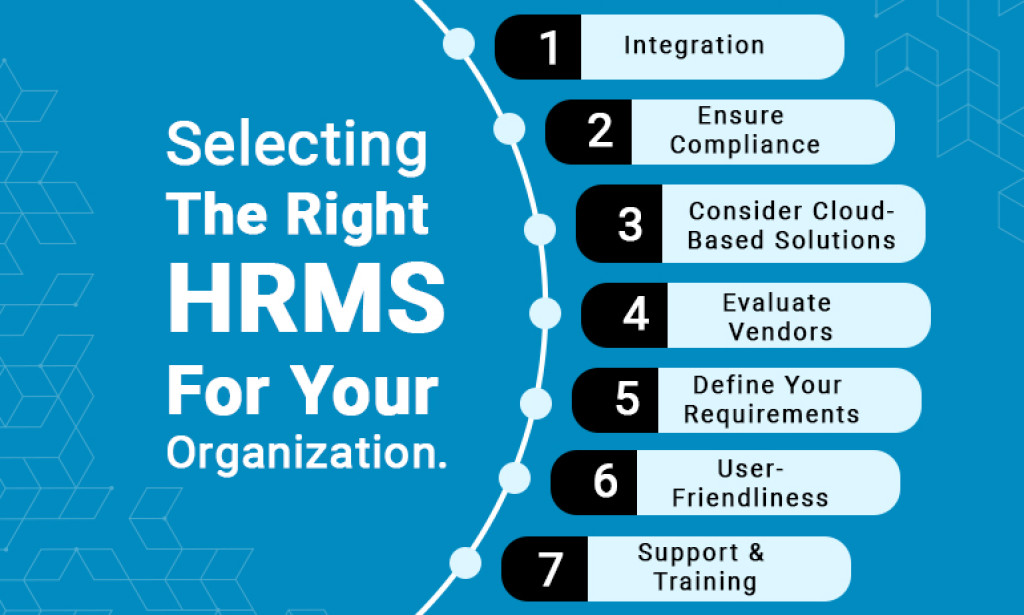
Selecting the right HRMS (Human Resource Management System) for your organization can be daunting, especially when considering the many available options. However, investing in the right HRMS can help streamline your HR processes, increase productivity, and enhance your employees' experience.
In this blog, we'll discuss 7 key factors to consider when selecting an HRMS.
1. Define Your Requirements:
The first step in selecting an HRMS is determining your organization's unique needs and requirements. Create a list of required functionalities and features, including payroll processing, benefits administration, time and attendance tracking, performance management, and more. By identifying your requirements upfront, you can ensure that your chosen HRMS meets your organization's needs.
2. Evaluate Vendors:
Once you have defined your requirements, you can start researching vendors that offer HRMS solutions. Look for vendors that have experience working with organizations in your industry and check their references and customer reviews. You can also ask for demos and product walkthroughs to evaluate the software's usability and functionality. This will help you narrow your options and choose the best HRMS vendor for your organization.
3. Consider Cloud-Based Solutions:
Cloud-based HRMS solutions offer many benefits, including cost savings, scalability, and flexibility. With a cloud-based HRMS, you don't have to worry about software updates or maintenance; your employees can access the software anywhere. Cloud-based solutions can also reduce IT costs and improve disaster recovery capabilities. Consider these benefits when evaluating HRMS options and choose a cloud-based solution if it makes sense for your organization.
4. Ensure Compliance:
When selecting an HRMS in the Indian context, compliance with relevant laws and regulations is critical. The HRMS should comply with Indian labor laws, such as the Factories Act, the Minimum Wages Act, and the Payment of Gratuity Act, to name a few. Employers in India are subject to numerous legal obligations related to their employees, and failure to comply with these laws can result in severe legal and financial consequences.
Therefore, ensuring that the HRMS is up to date with all compliance requirements in India is essential. The HRMS should have features and functionalities that support compliance with various Indian labor laws. This includes features that can help automate compliance tasks and maintain accurate records, such as attendance tracking, leave management, payroll processing, and compliance reporting.
In summary, it is crucial to select an HRMS that is compliant with Indian labor laws and regulations to avoid legal and financial risks. Ensure that the HRMS you choose is up to date with all compliance requirements and has the necessary features to support compliance with Indian labor laws.
5. Integration:
An HRMS that integrates with other business systems, such as your payroll system or applicant tracking system, can help streamline your HR processes and eliminate the need for manual data entry. Make sure the HRMS you choose can integrate with your existing systems. This will not only save you time but also improve the accuracy of your HR data.
6. User-Friendliness:
An HRMS that is easy to use and navigate can help improve adoption rates and user satisfaction. Look for an HRMS that offers a modern, intuitive user interface and that requires minimal training. Choose an HRMS that your employees will find easy to use, requiring minimal training.
7. Support and Training:
Your HRMS vendor should offer comprehensive training and support to ensure your organization gets the most out of the software. Ensure the vendor offers training for administrators and end-users and provides ongoing support and resources. This will help ensure that your organization can take full advantage of the HRMS and address any issues promptly.
In conclusion, selecting the right HRMS for your organization requires careful consideration and evaluation.
By defining your requirements, evaluating vendors, considering cloud-based solutions, ensuring compliance, integrating with other systems, prioritizing user-friendliness, and selecting a vendor that offers comprehensive support and training, you can ensure your organization selects an HRMS that meets your needs and helps you achieve your HR goals.
Take the time to evaluate your options and choose an HRMS that will benefit your organization for years.



You must be logged in to post a comment.